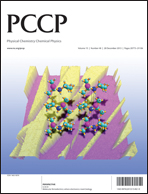Structural, energetic, spectroscopic and QTAIM analyses of cation–π interactions involving mono- and bi-cyclic ring fused benzene systems†
Abstract
The effect of increasing the number of monocyclic six-membered rings or bicyclic rings of bicyclo[2.1.1]hexenyl fused to benzene on cation–π interactions involving alkali metal ions (Li+, Na+, and K+) has been investigated. The binding energy data at the B3LYP/6-311+G(2d,2p) level clearly indicate that the binding affinity of the metal ion with benzene is enhanced by increasing the number of rings fused irrespective of a monocyclic or a bicyclic ring. Calculated binding energies are in good agreement with the available experimental results. The binding strength of cations with ligands decreases in the order Li+ > Na+ > K+. Our study establishes that trisannelation of bicyclo[2.1.1]hexene to benzene facilitates a very strong interaction between benzene and cations. Infrared (IR) frequencies and nuclear magnetic resonance (NMR) chemical shifts are shown to be valuable in characterizing cation–π interactions. The C–C bonds of the central six-membered rings are weakened due to metal ion binding. Based on the Quantum Theory of Atoms in Molecules (QTAIM), we have observed the presence of stabilizing H⋯H interactions in two of the considered systems as opposed to the frequent description of these interactions as non-bonded repulsive interactions. Alkali metal ion binding with those two ligands slightly reduces the strength of such H⋯H interactions.


 Please wait while we load your content...
Please wait while we load your content...